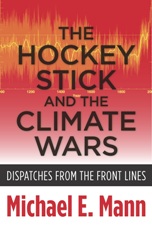
The Hockey Stick and the Climate Wars
Most geologists have spent precious little time on palaeoclimate studies since undergraduate days. In the absence of knowledge, prejudice often seeps in to the empty space, exacerbated by articles in the media or in the blogosphere. Michael Mann is one of the key people trying to fill that void with knowledge.
Many geologists recall that Britain’s eminent climatologist, H.H. Lamb, documented a European medieval climatic optimum in which temperatures between 400 and 1200 AD were warmer than those of the 1960s to 1980’s. What they fail to recall is that Lamb also showed that China and Japan missed this warm phase (Climate, History and the Modern World, 1995, p. 171).
Michael Mann has inherited Lamb’s mantle. Mann uses proxy measurements of northern hemisphere climate extracted from tree rings, ice cores, corals and sediment cores to identify natural variations in the climate system (e.g. Nature 378, 1995, 266-270). By 1999, Mann and his team discovered from palaeoclimate analyses that the extent of medieval warming was likely about the same as it was in the mid 20th century, and much less than that since 1970. The data followed a curve reminiscent of a ‘hockey stick’. If Lamb had added his Chinese data to his UK data he might have got a similar result.
The ‘hockey stick’ was anathema to those who wanted ardently to believe that late 20th century warming was not anomalous and had nothing to do with our emissions of CO2. Controversy followed from the global warming nay-saying community, not least through A W Montford’s 2010 attack on Mann in
The Hockey Stick Illusion. In the meantime, several peer-reviewed scientific studies by different authors have confirmed Mann’s original ‘hockey stick’ as being in the right ballpark, strongly suggesting that grounds for his impeachment are non-existent. Indeed, he was cleared of any wrongdoing by in-depth studies of his work by expert panels from the National Academy of Sciences (North, G.R., et al., 2006, Surface temperature reconstructions for the past 2000 years; National Academies Press, Washington DC), from his own university - Penn State, and from the US National Science Foundation. Like it or not, Mann remains a pioneer in analysing proxy records of climate change covering the past 1000 years, and one of the foremost young palaeoclimatologists of our time.
I heartily recommend this book for an unusually clear view of the action on the front line of climate science from one of its principle palaeoclimate protagonists.
Reviewed by Colin Summerhayes
THE HOCKEY STICK AND THE CLIMATE WARS – DISPATCHES FROM THE FRONT LINES. MICHAEL MANN. Published by Columbia Univ. Press. ISBN 978-0-231-15254-9. 395 pp. List price £19.95. cup.columbia.edu